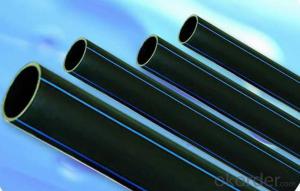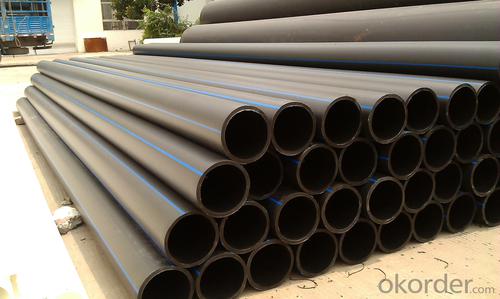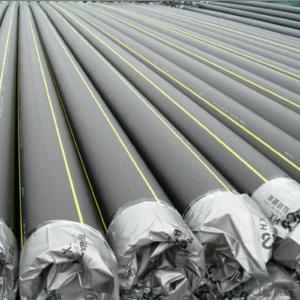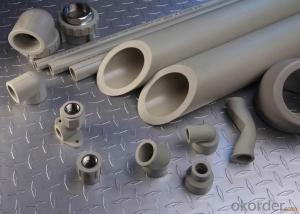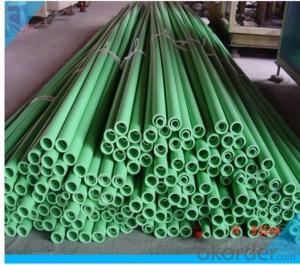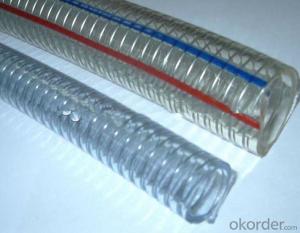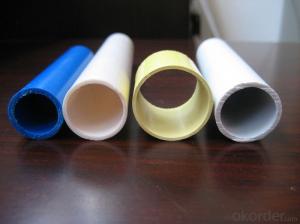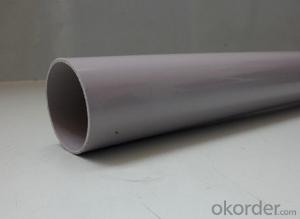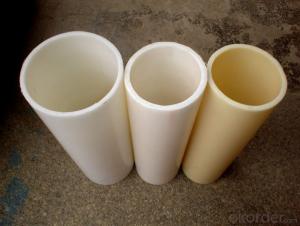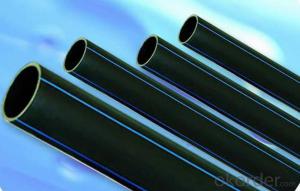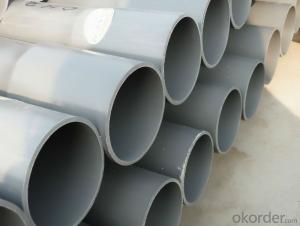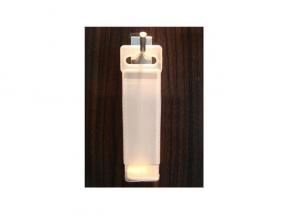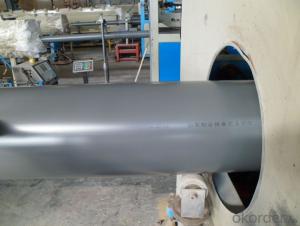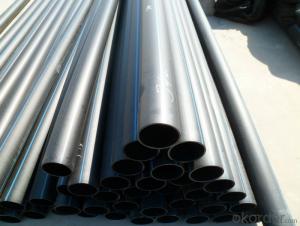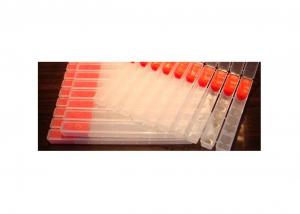HDPE Pipe ISO4427-2000 DN73 Plastic Tubes
- Loading Port:
- China Main Port
- Payment Terms:
- TT OR LC
- Min Order Qty:
- -
- Supply Capability:
- -
OKorder Service Pledge
OKorder Financial Service
You Might Also Like
Physical properties[edit]
Polyethylene is a thermoplasticpolymer consisting of long hydrocarbon chains. Depending on the crystallinity and molecular weight, a melting point and glass transition may or may not be observable. The temperature at which these occur varies strongly with the type of polyethylene. For common commercial grades of medium- and high-density polyethylene the melting point is typically in the range 120 to 180 °C (248 to 356 °F). The melting point for average, commercial, low-density polyethylene is typically 105 to 115 °C (221 to 239 °F).it is transprant.
Chemical properties[edit]
Most LDPE, MDPE and HDPE grades have excellent chemical resistance, meaning that it is not attacked by strong acids or strong bases. It is also resistant to gentle oxidants and reducing agents. Polyethylene burns slowly with a blue flame having a yellow tip and gives off an odour of paraffin. The material continues burning on removal of the flame source and produces a drip.[3] Crystalline samples do not dissolve at room temperature. Polyethylene (other than cross-linked polyethylene) usually can be dissolved at elevated temperatures in aromatic hydrocarbons such as toluene or xylene, or in chlorinated solvents such as trichloroethane or trichlorobenzene.[4]
GB/T13663-2000:
| PE63管材规格 | |||||
| 公称 外径dn,mm | SDR33 | SDR26 | SDR17.6 | SDR13.6 | SDR11 |
| 公称压力 PN,Mpa | |||||
| 0.32 | 0.4 | 0.6 | 0.8 | 1.0 | |
| 公称 壁厚 | 公称 壁厚 | 公称 壁厚 | 公称 壁厚 | 公称 壁厚 | |
| 16 | 2.3 | ||||
| 20 | 2.3 | 2.3 | |||
| 25 | 2.3 | 2.3 | 2.3 | ||
| 32 | 2.3 | 2.4 | 2.9 | ||
| 40 | 2.3 | 2.3 | 3.0 | 3.7 | |
| 50 | 2.3 | 2.9 | 3.7 | 4.6 | |
| 63 | 2.3 | 2.5 | 3.6 | 4.7 | 5.8 |
| 75 | 2.3 | 2.9 | 4.3 | 5.6 | 6.8 |
| 90 | 2.8 | 3.5 | 5.1 | 6.7 | 8.2 |
| 110 | 3.4 | 4.2 | 6.3 | 8.1 | 10.0 |
| 125 | 3.9 | 4.8 | 7.1 | 9.2 | 11.4 |
| 140 | 4.3 | 5.4 | 8.0 | 10.3 | 12.7 |
| 160 | 4.9 | 6.2 | 9.1 | 11.8 | 14.6 |
| 180 | 5.5 | 6.9 | 10.2 | 13.3 | 16.4 |
| 200 | 6.2 | 7.7 | 11.4 | 14.7 | 18.2 |
| 225 | 6.9 | 8.6 | 12.8 | 16.6 | 20.5 |
| 250 | 7.7 | 9.6 | 14.2 | 18.4 | 22.7 |
| 280 | 8.6 | 10.7 | 15.9 | 20.6 | 25.4 |
| 315 | 9.7 | 12.1 | 17.9 | 23.2 | 28.6 |
| 355 | 10.9 | 13.6 | 20.1 | 26.1 | 32.2 |
| 400 | 12.3 | 15.3 | 22.7 | 29.4 | 36.3 |
| 450 | 13.8 | 17.2 | 25.5 | 33.1 | 40.9 |
| 500 | 15.3 | 19.1 | 28.3 | 36.8 | 45.4 |
| 560 | 17.2 | 21.4 | 31.7 | 41.2 | 50.8 |
| 630 | 19.3 | 24.1 | 35.7 | 46.3 | 57.2 |
- Q: Can plastic tubes be used for underground applications?
- Yes, plastic tubes can be used for underground applications. Plastic tubes are commonly used for various underground applications such as water supply, drainage systems, and underground wiring. They are preferred for their durability, resistance to corrosion, and ease of installation.
- Q: How do plastic tubes compare to glass tubes in terms of strength?
- Plastic tubes generally have lower strength compared to glass tubes. Glass tubes are known for their high resistance to breakage and ability to withstand high pressures, making them stronger and more durable than plastic tubes.
- Q: What is the cost of plastic tubes?
- The cost of plastic tubes can vary depending on factors such as size, material, and quantity. It is best to contact a supplier or check online platforms for current pricing information.
- Q: Is the PPR plastic pipe really poisonous? Is the news true?
- The main component of the PPR tube is polypropylene, is non-toxic, but individual manufacturers due to the pursuit of high profits, the production of inferior water, most people will lead to misunderstanding, to distinguish between true and false, false tube has a pungent odor, if not smell, you can intercept a short combustion to see whether there is a pungent odor, if any, that is inferior tube, is harmful to the human body. In addition, if you don't worry about using the PPR tube, you can replace the PPR tube with copper core, but the price is a little more expensive.
- Q: Are plastic tubes resistant to static electricity?
- Plastic tubes are generally not resistant to static electricity, as they are insulators that do not conduct electricity.
- Q: How do plastic tubes compare to polypropylene tubes in terms of chemical resistance?
- Polypropylene tubes generally have better chemical resistance than plastic tubes. Polypropylene is highly resistant to a wide range of chemicals, including acids, alkalis, and organic solvents. Plastic tubes, on the other hand, can be made from various materials such as PVC or polyethylene, which may not offer the same level of chemical resistance as polypropylene. Therefore, when it comes to chemical resistance, polypropylene tubes are usually the better choice.
- Q: the tubes are bout 1cm ID with only about a 1mm thickness. I don't think threading them will be possible, and the seal between that has to be water tight.
- It really depends on the material you have, i would go and find a smaller pipe that fits in there tightly and then glue it in or you can find a sleeve that fits on the outside and glue it !
- Q: I have lots of hamster space all connected with tubes, and each area is colorful and some have wires. I have had hamsters in the past, but never more than one at a time. I want another hamster to replace the one I had for almost 4 years but then passed away. The thing is, I don't know if I should get more than one hamster at the same time, and also I don't know what kind of hamster/s I should get. Please help!
- Get one syrian hamster as they if they are kept together they will fight and in most cases kill each other. Syrians also love tubes and wires and anything they can play or climb on. I have found the males to be friendliest. I'd advise going to a good breeder as these have handled the baby hamsters from being tiny making them very friendly and they will also give you loads of great advice.
- Q: Can duct tape be used to fix flexible plastic tubing? We sprung a leak in the flexible plastic tubing last night and so I am hoping I can just use duct tape to fix the small crack in the flexible plastic tubing. Thanks,Jeff
- Hi, If the water is going through the tube (pressurized) then you can't, if it's an a/c drain tub then you can.
- Q: What is the maximum temperature plastic tubes can withstand?
- The maximum temperature that plastic tubes can withstand varies depending on the specific type of plastic used. However, in general, many plastic tubes can withstand temperatures up to approximately 150-200 degrees Celsius.
Send your message to us
HDPE Pipe ISO4427-2000 DN73 Plastic Tubes
- Loading Port:
- China Main Port
- Payment Terms:
- TT OR LC
- Min Order Qty:
- -
- Supply Capability:
- -
OKorder Service Pledge
OKorder Financial Service
Similar products
Hot products
Hot Searches
Related keywords

